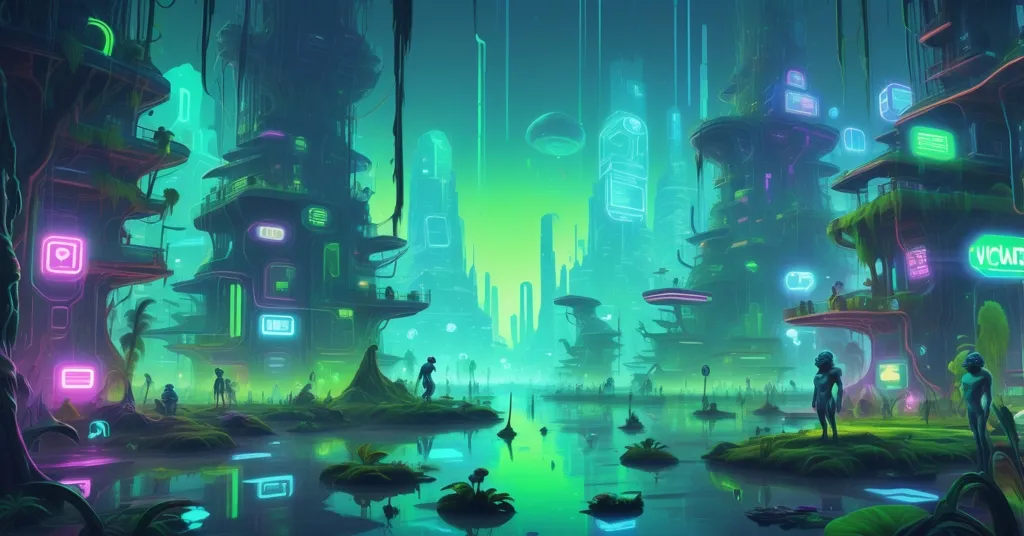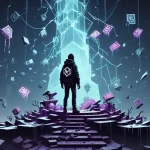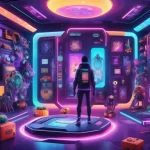Yuga Labs Unveils Otherside Metaverse: A Web3 Gaming Revolution or Risky Gamble?

Bored Ape Creators Launch Otherside Metaverse: Web3’s Big Gamble
Yuga Labs, the brains behind the Bored Ape Yacht Club (BAYC), dropped a bombshell at ApeFest in Las Vegas with the unveiling of their long-delayed metaverse project, Otherside, set to go live on November 12. Touted as a fusion of gaming, social interaction, and blockchain technology, Otherside is gunning to challenge Web2 giants like Fortnite, Roblox, and Minecraft. But in a space notorious for overblown promises, can this Web3 gaming platform deliver, or is it just another shiny distraction?
- Launch Date: Otherside hits the scene on November 12.
- Core Pitch: A metaverse mixing gaming, community, and NFT ownership with a creator-first focus.
- Target: Competing with Fortnite, Roblox, and Minecraft via blockchain innovation.
What Is Otherside? Decoding the Metaverse
For the uninitiated, a metaverse is essentially a shared digital world where people can hang out, play games, create stuff, and interact as if it’s a parallel universe. Think of it as the internet, but immersive—less scrolling, more living. Otherside, crafted by Yuga Labs, aims to be exactly that: a sprawling virtual playground rooted in the quirky aesthetic of Bored Ape Yacht Club. It’s launching with distinct zones like The Swamp, a murky nod to BAYC’s swamp ape lore, and Nexus, a central hub buzzing with activity. Early games, built by the community, carry oddball names like Bathroom Blitz, suggesting a chaotic, playful vibe. For more on the launch details, check out the latest update on the Bored Ape metaverse debut.
Getting in is designed to be painless. Whether you’re a crypto newbie or a wallet-wielding veteran, you can sign up with just an email or connect a crypto wallet. No need to decipher blockchain hieroglyphs. A big draw is the integration of NFTs—Non-Fungible Tokens, which are unique digital assets verified on a blockchain, kind of like a forgery-proof deed for digital goods. In Otherside, these NFTs can be avatars from collections like BAYC or custom creations via the Voyager tool. So, your overpriced ape JPEG? It might just become your in-game persona. Social features include Bubbles, audio chat rooms similar to Discord or X Spaces, letting you banter in real-time while roaming this digital swamp.
Web3 vs. Web2: A Gaming Showdown
Otherside isn’t just another gaming app; it’s a middle finger to the Web2 status quo. Traditional platforms like Roblox or Fortnite often shaft developers with lousy revenue splits—some creators on Roblox reportedly earn peanuts after platform cuts. Yuga Labs wants to flip this on its head with a Web3 approach, emphasizing decentralized ownership. Here’s the gist: instead of a corporation controlling your in-game loot (and potentially wiping it on a whim), blockchain tech ensures you truly own your digital assets—avatars, items, whatever—and can trade or sell them outside the platform. It’s like owning a real-world collectible, but digital.
For developers, Yuga Labs is rolling out the Otherside Development Kit (ODK), a set of tools based on Unreal Engine—a popular game development platform—to build blockchain-powered experiences. Imagine a small indie dev crafting a mini-game within Otherside, designing unique skins or levels, and selling them as NFTs directly to players, pocketing most of the profits without a corporate middleman skimming off the top. Michael Figge, Chief Product Officer at Yuga Labs, framed it as a game-changer:
“The O.D.K. is a set of tools that allows you to build in Unreal Engine to create next-generation blockchain experiences… This is a big opportunity.”
Figge also hinted at the broader vision, suggesting this creator-first ethos could explode in scale:
“A differentiated approach with a Web3 creator-first ethos could hit massive scale.”
If they pull it off, it could empower a new wave of creators tired of being squeezed by Web2 overlords. But here’s the kicker: will gamers and developers care enough to jump ship from familiar ecosystems?
Partnerships: Dragging Web3 into the Mainstream
Yuga Labs isn’t playing small ball with Otherside. They’ve secured eyebrow-raising collaborations to boost visibility. A tie-up with Amazon—yes, the retail behemoth—will spawn a co-branded NFT avatar collection called Boximus. This isn’t just a gimmick; it’s a potential gateway for blockchain tech to sneak into everyday consumer consciousness. Picture this: someone browsing Amazon for headphones stumbles upon Boximus avatars, dips a toe into Otherside, and suddenly they’re dabbling in NFTs without realizing it. That’s the kind of bridge Web3 desperately needs.
Another partnership with digital artist Daniel Arsham will introduce a distinct avatar drop, injecting artistic cred into the mix. These moves aren’t mere hype fuel; they signal an intent to mesh the often niche world of Web3 with broader markets. The reveal event itself, an IRL livestream at HyperX Arena in Las Vegas supported by OpenSea, pulled over 22,000 viewers during ApeFest. That’s tangible buzz. But can these partnerships translate into lasting adoption, or are they just flashy PR stunts?
The Hype vs. The Hard Truth
Let’s not get too starry-eyed. Back in 2022, Yuga Labs raised a whopping $450 million to build Otherside, riding the peak of the NFT and metaverse craze. Then, crickets. For over two years, the project ghosted the community, mirroring the broader crypto industry’s struggle with overpromising and underdelivering. Remember Decentraland? Hyped as a virtual utopia, it now often sits empty with user counts in the low thousands—hardly the revolution it promised. Otherside’s delayed rollout smells of similar growing pains, and Figge himself admitted the sheer scale of the project, calling it:
“One of the most ambitious projects ever attempted in the space. It’s finally starting to take shape.”
But ambition alone doesn’t win. Otherside faces technical hurdles—blockchain gaming isn’t exactly known for buttery-smooth performance. Most NFT ecosystems run on Ethereum, where high gas fees (transaction costs) and network congestion can make simple actions like buying an avatar a pricey pain. Will Yuga Labs use a layer-2 solution to cut costs and lag, or will players rage-quit over sluggish gameplay? And let’s talk user experience: if onboarding isn’t seamless, or if the world feels like a glorified tech demo, gamers will ditch it faster than a scammer after a rug pull.
Then there’s the NFT stigma. The crypto bear market tanked BAYC valuations, and public perception often paints NFTs as speculative bubbles or outright scams. Convincing mainstream gamers that digital ownership isn’t just crypto’s latest shiny toy will be an uphill battle. Add to that the competition—Fortnite and Roblox boast millions of daily users hooked on polished, familiar systems. Can a decentralized platform scale to those numbers without buckling or selling out its Web3 soul?
Bitcoin’s Place in a Metaverse Future
While Otherside likely runs on Ethereum or a related chain for its NFT mechanics, let’s not forget Bitcoin’s potential role in this digital frontier. As the bedrock of decentralization, Bitcoin could emerge as a reserve currency in metaverse economies. Imagine using Lightning Network micropayments—fast, cheap Bitcoin transactions—for in-game purchases like avatar gear or tipping creators. It’s not a stretch; Bitcoin’s security and global recognition make it a stable anchor in volatile virtual worlds, even if altcoins like Ethereum handle the flashy NFT stuff. For us Bitcoin maximalists, this is the dream: BTC as the universal money layer while other protocols fill niche gaps. Could Otherside integrate something like this down the line? It’s worth pondering.
Devil’s Advocate: Do Gamers Even Want Web3?
Let’s play skeptic for a moment. Do gamers really give a damn about blockchain or NFT ownership? Most Fortnite players just want to drop in, build, and shoot—not fuss over digital deeds. Is Otherside solving a problem that doesn’t exist for the average joystick junkie, or is it just crypto’s latest attempt to shoehorn decentralization into everything? On one hand, the empowerment angle is real: owning your in-game assets protects you from corporate whims—Web2 games can nuke your inventory overnight. On the other, it risks being a gimmick if the gameplay sucks or costs spiral. Yuga Labs has to prove this isn’t just a sandbox for crypto degens but a genuinely fun world worth escaping to.
What’s Next for Otherside?
As November 12 looms, the crypto and gaming crowds are watching with equal parts hype and doubt. Yuga Labs has the pedigree, the funding, and the vision to pull off something groundbreaking. But the road to a decentralized gaming utopia is paved with failed experiments and broken promises. If Otherside flops, will BAYC apes become the most expensive paperweights in gaming history? We’ll be tracking this closely, and come launch, we’ll dive into user feedback and performance to separate fact from fluff. For now, it’s a high-stakes bet in a space that desperately needs a win.
Key Questions and Takeaways
- What is Otherside, and how does it connect to Bored Ape Yacht Club?
Otherside is Yuga Labs’ metaverse project, merging gaming and social features with blockchain tech, steeped in BAYC branding through themed zones like The Swamp and NFT avatar integration. - How does Otherside differ from platforms like Fortnite or Roblox?
It stands out with blockchain-based asset ownership, letting users trade avatars and items externally, plus a creator-first focus via tools like the Otherside Development Kit for better earnings. - What are the biggest risks for Otherside’s success?
Past metaverse failures breed skepticism, while technical issues like blockchain scalability, high costs, and competition from gaming giants could derail mass adoption if execution stumbles. - Why is the Amazon partnership a big deal for Web3?
Teaming up with Amazon on the Boximus avatar collection could mainstream NFTs and blockchain concepts, exposing everyday consumers to Web3 through a trusted retail giant. - Could Bitcoin play a role in Otherside’s economy?
Potentially, Bitcoin via Lightning Network could enable fast, cheap in-game payments or act as a stable reserve currency, complementing Ethereum’s NFT focus in virtual worlds. - Does Web3 gaming have a shot at disrupting Web2 dominance?
It’s possible if Otherside nails user experience and creator incentives, but it must overcome gamer inertia and negative NFT perceptions to lure millions from entrenched platforms.



